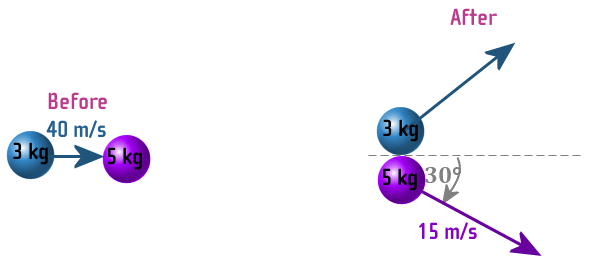Exercise 7E
Conservation of Vector Momentum
So, we know that momentum and impulse are vectors (Ex 7B),
and we know that, in a collision, momentum is conserved (Ex
7D)...
...so, simply by applying conservation of momentum to cases
where the momentum is given as a vector, we can understand
questions involving conservation of vector momentum...
e.g. A 3 kg particle, travelling at 40 m/s due east, strikes
a stationary body of mass 5 kg.
After the collision, the 5 kg particle moves on a bearing of
120°N at 15 m/s.
What is the speed of the 3 kg particle after the collision?
So, our before and after diagrams look like this:

We want to find the speed (which is a scalar) of the blue
particle after the collision, but since we will start off by
using vector momentum, I will show the Horizontal and Vertical
components of the velocity of the blue particle:

Then applying conservation of momentum separately along x
(then along y):
CoM (along x): (3)(40) + (5)(0) = (3)(H) + (5)(15cos30) ───────► H = 18.35 m/s
CoM (along y): (3)(0) + (0)(0) = (3)(V) + (5)(-15sin30) ───────► V = 12.5 m/s
So, we've worked out the vertical and horizontal components
of the velocity of the blue blob, after the collision - bu they
want the SPEED of the blue blob:
√18.35² + 12.5² = 22.2 m/s
Question 1: So, our before and after diagrams look
like this:

Now, since are are going to be using vectors, let's find the
horizontal and vertical components for the 600 m/s, but for the
v, let's just write the horizontal and vertical components of v
as H and V:

Then applying conservation of momentum separately along x
(then along y):
CoM (along x): (30)(0) = (10)(600cos45) + (20)(-H) ───────► H = ... m/s
CoM (along y): (30)(400) = (10)(600sin45) + (20)(-V) ───────► V = ... m/s
So, we've worked out the vertical and horizontal components
of the velocity of the black fragment, after the collision - but
they want its SPEED:
√...² + ...² = ... m/s
Question 2: Let's imagine the 1.2 kg stone is sliding
to the right at 16 m/s, and lets imagine that, after the
collision, it is moving at 10 m/s at 60° above the x-axis...
We don't know which way the second particle moves after being
hit, but I'd guess is moves to the right and below the x-axis -
so lets give it a component of H (to the right( and a component
of V (down):
Do a good sketch and then apply conservation of momentum
separately along x (then along y):
CoM (along x): (1.2)(16) + (2)(0) = (1.2)(10cos60) + (2)(H) ───────► H = ... m/s
CoM (along y): (1.2)(0) + (2)(0) = (1.2)(10sin45) + (2)(-V) ───────► V = ... m/s
So, we've worked out the vertical and horizontal components
of the velocity of the 2 kg stone - so now work out its speed...
|



